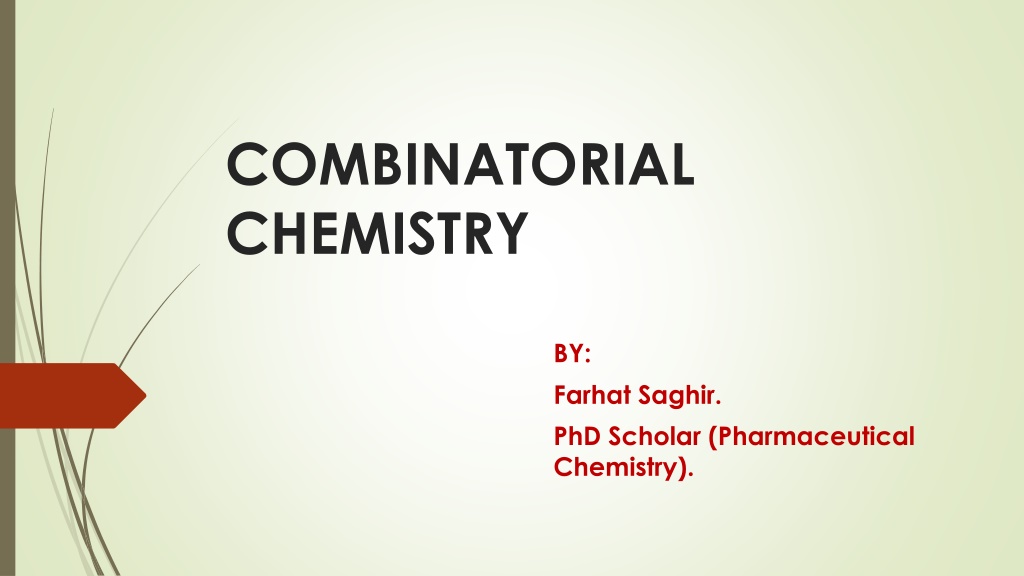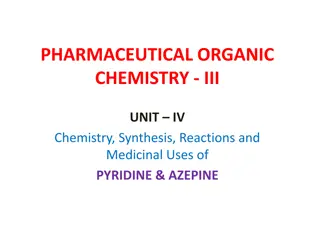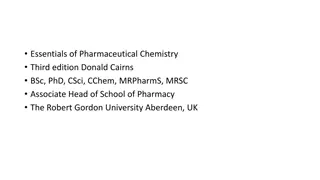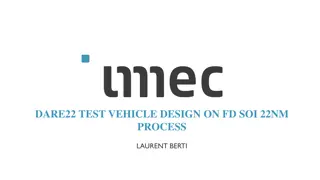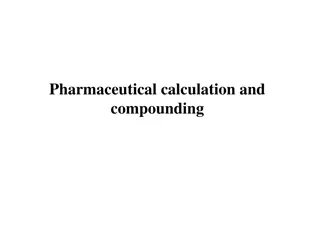Understanding Combinatorial Chemistry in Pharmaceutical Research
Combinatorial chemistry is a powerful method in drug discovery allowing for the synthesis of a large number of compounds simultaneously. This process helps in lead identification and optimization, enabling the screening of diverse compound libraries for potential biological activity. Various design approaches such as linear synthesis and template methods are used to create analogs efficiently. The ideal reactions for combinatorial chemistry should be specific, easy to perform, and provide high yields with a wide range of structural outcomes.
Download Presentation

Please find below an Image/Link to download the presentation.
The content on the website is provided AS IS for your information and personal use only. It may not be sold, licensed, or shared on other websites without obtaining consent from the author. Download presentation by click this link. If you encounter any issues during the download, it is possible that the publisher has removed the file from their server.
E N D
Presentation Transcript
COMBINATORIAL CHEMISTRY BY: Farhat Saghir. PhD Scholar (Pharmaceutical Chemistry).
DEFINITION Combinatorial chemical synthetic methods that make it possible to prepare a large number (tens to thousands or compounds in a single process using a defined reaction route and a large variety of reactants (building blocks). chemistry comprises even millions) of
Introduction Main function of combinatorial chemistry is the Lead identification & lead optimization e.g. in the drug discovery process. Normally this synthesis is carried out on small scale using solid phase synthesis and automated synthetic machines. The compounds formed can then be tested for biological activity. The products of such a process are known as a combinatorial library . Its size depends on the number of building blocks used per reaction and the number of reaction steps, in which a new building block is introduced. Typical size ranges from 102 up to 105 compounds. These compound libraries can be made as mixtures, sets of individual compounds or chemical structures generated in computer. In a traditional organic synthesis lab, the chemist does the standard reaction A + B C. But with combinatorial chemistry A is a mixture of perhaps 5 components and B is a mixture of 10 so instead of getting one product the chemist now gets 50. Strategies that allow identification of useful components of the libraries are also part of combinatorial chemistry.
Principle The principle of combinatorial chemistry is to make a large range of analogues by using the same reaction conditions and in the same reaction vessels. In this way, the chemist can synthesize many hundreds compounds at one time instead of preparing only a few by simple methodology. or thousands of
Design of combinatorial synthesis 1. Linear Synthesis: In this case the building blocks are successively added to the preceding structure so that it grows in only one direction (linear synthesis). It usually relies on the medicinal chemist finding suitable protecting groups so that the reactions are selective. This design approach is useful if the product is a polymer (oligomer) formed from a small number of monomeric units (Fig. 5.3a) 2. Template Method: The synthesis can proceed in different directions from an initial building block known as a template provided that the template has either the necessary functional groups or they can be generated during the course of the synthesis (Fig. 5.3b). Both routes may require the use of protecting groups.
Criteria for Ideal Reaction 1. The reactions should be specific, relatively easy to carry out and give a high yield. 2. The reactions used in the sequence should allow for the formation of as wide a range of structures for the final products as possible, including all the possible stereoisomers. 3. The reactions should be suitable for use in automated equipment. 4. The building blocks should be readily available. 5. The building blocks should be as diverse as possible so that the range of final products includes structures that utilize all the types of bonding to bind to or react with the target. 6. It must be possible to accurately determine the structures of the final products. Note: In practice it is not always possible to select reactions that meet all these criteria. However, criterion 6 must be satisfied otherwise there is little point in carrying out the synthesis.
Selection of building blocks: The degree of information available about the intended target will also influence the selection of the building blocks. If little is known a random selection of building blocks is used in order to identify a lead. However, if there is a known lead, the building blocks are selected so that they produce analogues that are related to the structure of the lead. This allows the investigator to study the SAR/QSAR and/or determine the potency. optimum structure for
The general techniques used in combinatorial synthesis: Combinatorial synthesis may be carried out on: 1. on a solid support Parallel Synthesis Manual method Furka s Mixed & split Combinatorial Synthesis 2. in solution phase using either linear synthesis or template method. Both solid support and solution synthetic methods may be used to produce libraries that consist of either individual compounds or mixtures of compounds. Automated
1. The solid support method In this type of method the reactants are bound to a polymeric surface and modified whilst still attached. Final product is released at the end of the synthesis. In this method, the reaction is carried out on a solid support such as resin beads. The solid phase synthesis was pioneered by Merrifield synthesis of peptides. The bead is treated with different starting materials which bound together. Then it is mixed with another reagent to get the product which is bound to solid support. The excess reagent or by product can be easily removed by washing with appropriate solvent.
Requirements/important considerations 1. Types of Supports: Solid support combinatorial chemistry has been carried out on a variety of supports that include polymer beads, arrays of wells, arrays of pins, glass plates, spatial arrays on microchips and cellulose sheets. However, most syntheses are performed using polymer beads. 2. Role & Choice of Linker: The group that anchors the compound being synthesized to the bead is known either as a handle or a linker. As well as modifying the properties of the bead, the linkers move the point of substrate attachment further from the bead, making reaction easier. The choice of linker will depend on the nature of the reactions used in the proposed synthetic pathway. For example, (1). (hydroxymethylphenoxy), would not be suitable if the reaction pathway contained reactions that were conducted under strongly acidic conditions. The link must be stable to the reaction conditions in the synthesis but easily cleaved to release the final product at the end of the synthesis. An acid-labile linker, such as HMP
3. Protecting groups: In order to carry out a reaction on only one functional group of a multi-functional group compound, the reactivity of the rest of the functional groups needs to be suppressed. This can be achieved by application of protecting groups. A protecting group is reversibly attached to the functional group to convert it to a less reactive form. When the protection is no longer needed, the protecting group is cleaved and the original functionality is restored. It is an important requirement for a protecting group to be stable under the expected reaction conditions and to be cleavable - if possible - at mild reaction conditions.
Examples: A few protecting groups used in solid phase synthesis. For amines: 1. Boc ( t-butoxycarbonyl ) 2. Fmoc (9-fluorenylmetoxy carbonyl) 3. Tmsec (2 [ trimethylsilyl ] ethoxycarbonyl) For carboxylic acids: 1. Tert Bu ester(t-butyl ester) 2. Fm ester(9-fluronyl methyl ester) 3. Tmse ester(2 [trimethylsilyl] ethyl)
4. Method Employed It must not damage the required product but must also lend itself to automation. Combinatorial synthesis on solid supports is usually carried out either by using (1). Parallel synthesis or (2). Furka s mix and split procedure, depending on the nature of the combinatorial library being produced and also the objectives of the investigating team.
5. Combinatorial Library: Identification of Components of It is necessary to determine the structures of the components of the library by either keeping a detailed record of the steps involved in the synthesis or giving beads with a label that can be decoded to give the structure of the compound attached to that bead. The method adopted to identify the components of the library will depend on the nature of the synthesis.
1. Parallel Synthesis(Useful for SAR and drug optimization) This technique is normally used to prepare combinatorial libraries that consist of separate compounds. It is not suitable for the production of libraries containing thousands to millions of compounds. In parallel synthesis the compounds are prepared in separate reaction vessels but at the same time, that is, in parallel. The array of individual reaction vessels often takes the form of either a grid of wells in a plastic plate or a grid of plastic rods called pins attached to a plastic base plate (Fig. 5.7) that fits into a corresponding set of wells.
In the former case the synthesis is carried out on beads placed in the wells whilst in the latter case it takes place on so-called plastic crowns pushed on to the tops of the pins, the building blocks being attached to these crowns by linkers similar to those found on the resin beads.
Automated Parallel Synthesis Automated synthesizers are available with 42, 96 or 144 reaction vessels or wells Use beads or pins for solid phase support Reactions and work ups are carried out automatically Same synthetic route used for each vessel, but different reagents Different product obtained per vessel.
Houghtons Tea Bag Procedure: It is a parallel synthetic method using polymer beads as solid support. Tea Bag: It is a polypropylene (permeable plastic) mesh bag, with dimensions of approximately 15 x 20 mm, filled with resin beads, sealed and labeled for a later identification, designed by Houghton (1985). The principles of its use are to make multi milligram (up to 500 moles) quantities of a single peptide sequence in each packet, which is sufficient for full characterization and screening. The tea-bag mesh size is too small to allow resin beads to escape, but solvents and soluble reagents could readily enter. A single product is synthesized within each teabag. Different products are formed in different teabags because separate reactions are carried out on each tea bag.
Schematic overview of the steps carried out using the tea-bag procedure.
To save time and work when making many peptides simultaneously, bags could be combined into the same reactors for common chemical steps. For example, in the synthesis of 40 different peptides, all the bags are initially charged with resin beads bearing a Boc-protected amino acid, and the packets are combined for resin deprotection, washing, and neutralization steps. Then the bags are sorted into groups for the addition of the next amino acid. Then the bags could be combined again for deprotection, washing, and neutralization. After an appropriate number coupling steps, all the bags can then be treated with HF/anisole to cleave the peptides from the beads.
All operations, including removal of protecting groups, couplings, washings and even the cleavages were performed on the solid supports enclosed into the same bags. As the first intention was to speed up peptide synthesis, nowadays the teabag method is a classic example for combinatorial synthesis, its speed, and effectiveness. Note: It is cheap and possible for any lab but being manual procedure it is not suitable for producing large quantities of different products. Advantage: Less number of operations is needed than in a normal parallel synthesis and the number of reaction vessels is also less than the number of the synthesized compounds.
Fodors method for parallel synthesis: In theory almost any solid material can be used as the solid support for parallel combinatorial synthesis. Fodor (1991) produced peptide libraries using a form of parallel synthesis that could be performed on a glass plate. The plate is treated so that its surface is coated with hydrocarbon chains containing a terminal amino group. These nitroveratryloxycarbonyl (NVOC) group. amino groups are protected by the UV-labile 6- A photolithography mask (M1) is placed over the plate so that only a specific area of the plate can be irradiated with UV light (Fig. 5.10).
This results in removal of the NVOC protecting group from the amino groups in the irradiated area. The entire plate is exposed to the first activated NVOC-protected amino acid. However, it will only bond to the amino groups exposed in the irradiated area (Step A). The process is repeated using a new mask (M2) and a second activated NVOC- protected amino acid attached to the exposed amino groups (Step B). This process is repeated using different masks (M3, etc.) until the desired library is obtained, the structure of the peptide occupying a point on the plate depending on the masks used and the activated NVOC-protected amino acid used at each stage in the synthesis. The technique is so precise that it has been reported that each compound occupies an area of about 50 m x 50 m. A record of the way in which the masks are used will determine both the order in which the amino acids are added and, as a result, the structure of each of the peptides at specific coordinates on the plate.
2. Furkas mix and split technique: Developed by Furka and co-workers from 1988 to 1991. It uses resin beads and may be used to make both large (thousands) and small (hundreds) combinatorial libraries. Large libraries are possible because the technique produces one type of compound on each bead, that is, all the molecules formed on one bead are the same but different from those formed on all the other beads. Each bead will yield up to 6 x 1013 product molecules, which is sufficient to carry out high-throughput screening procedures. Advantage: it reduces the number of reactions required to produce a large library.
For example, if the synthetic pathway required three steps, it would require 30,000 separate reaction vessels to produce a library of 10,000 compounds if the reactions were carried out in separate reaction vessels using orthodox chemical methods. The Furka mix and split method reduces this to about 22 reactions. The Furka method produces the library of compounds on resin beads. These beads are divided into a number of equally sized portions corresponding to the number of initial building blocks. Each of the starting compounds is attached to its own group of beads using the appropriate chemical reaction (Fig.5.11)
All the portions of beads are now mixed and separated into the number of equal portions corresponding to the number of different starting compounds being used for the first stage of the synthesis. A different reactant building block is added to each portion and the reaction is carried out by putting the mixtures of resin beads and reactants in a suitable reaction vessel. After reaction, all the beads are mixed before separating them into the number of equal portions corresponding to the number of building blocks being used in the second stage of the synthesis. A different second stage building block is added to each of these new portions and the mixture is allowed to react to produce the products for this stage in the synthesis. This process of mix and split is continued until the required library is synthesized. In peptide and similar polymer library formation where the same building blocks are used at each step, the maximum possible number of compounds that can be synthesized for a given number of different building blocks ( b) is given by: No. of compounds= bxWhere x is the number of steps in the synthesis. Unlike in parallel synthesis. the history of the bead cannot be traced from a grid reference, it has to be traced using either a suitable encoding method or deconvolution.
Applications of Solid Phase Synthesis Synthesis of 1,4-benzodiazepines Synthesis of Benzopyran derivatives Synthesis of luteinizing hormone analogues etc. hormone releasing
2. Solution Phase Synthesis The solution phase synthesis involves conducting chemical reaction simultaneously, preferably in well ordered sets (arrays) of reaction vessels in solution. For example, the preparation of small array of amides, which consists of placing different acid chlorides and amines in each of matrix reaction vessel (along with tertiary amine to neutralize liberated hydrochloric acid), incubating and performing liquid-liquid extraction. Evaporation of the solvent gives crude amides, which can be tested directly in biological assay
Disadvantage The main disadvantage of this method is when number of reagents are taken together in solution, it can result in several side reactions and may lead to polymerization giving a tarry mass. Therefore, to avoid this, the new approach is developed in which all-chemical structure combinations are prepared separately, in parallel on a given building block using an automated robotic apparatus. Hundreds and thousands of vials are used to perform the reactions and laboratory robots are programmed to deliver specific reagents to each vial.
Advantages of Combinatorial Chemistry Fast Combinatorial approach can give rise to millions of compound in same time as it will take to produce one compound by traditional method of synthesis. Economical A negative result of mixture saves the effort of synthesis, purification & identification of each compound. Easy Isolation purification & identification of active molecule from combinatorial library is relatively easy
Drug Discovery Mixed Combinatorial synthesis produces chemical pool. Probability of finding a molecule in a random screening process is proportional to the number of molecules subjected to the screening process. Drug Optimization Parallel synthesis produces analogues with slight differences. Disadvantages Efficiency is highly affected by compound's size, solubility and function group. Compounds produced tend to be Achiral of Racemic.
Applications of Combinatorial Chemistry Applications of combinatorial chemistry are very wide. Scientists use combinatorial chemistry to create large populations of molecules that can be screened efficiently. The application of combinatorial chemistry science has revolutionized high-throughput screening paradigms, chemical purification and post purification. Drug Discovery and Design: Combinatorial chemistry is mainly applied in the discovery of drugs. For example; Raloxifen. It is used in drug design and has impact on development of chemical compound to lead and in lead optimization. lead optimization, library
Synthesis of Analogues: It is used to synthesize analogues of existing lead structure to elucidate the structure activity relationship (SAR). As, preparation of hydrazones and discovery of an antibiotic compounds by use of traditional synthesis.
Targeted and Diversified Libraries: By producing larger, targeted and more diverse compound libraries, companies increase the probability that they will find novel compounds of significant therapeutic and commercial value. Use of Advanced Software and Robotics: Provides a stimulus immobilization strategies that allow high-throughput and multiple parallel approaches to drug discovery. Less Time Consuming : Fast Combinatorial approach can give rise to millions of compound in same time as it will take to produce one compound by traditional method of synthesis. for robot-controlled and
Purification and Identification of Active Molecules: Isolation, purification & identification of active molecule from combinatorial library is relatively easy. Use In Agro Chemical Sector: Combinatorial chemistry had a major impact not only on the pharmaceutical research but also in agrochemical research. It is being used in many fields of agrochemical research like in; insecticides, fungicides, herbicides. Use in Miniaturization: Combinatorial chemistry automation to synthesize large compound libraries instead of synthesizing single compound as in the case of traditional drug design method. exploits miniaturization and
